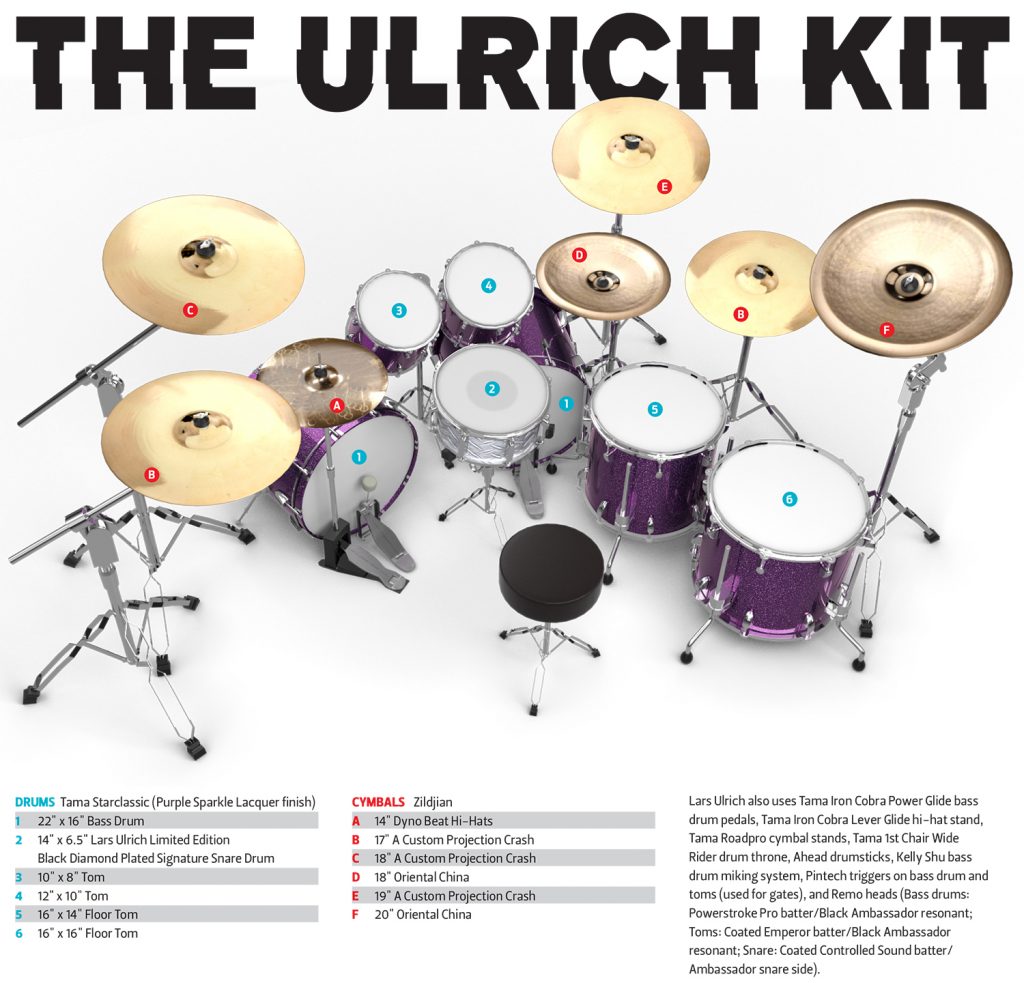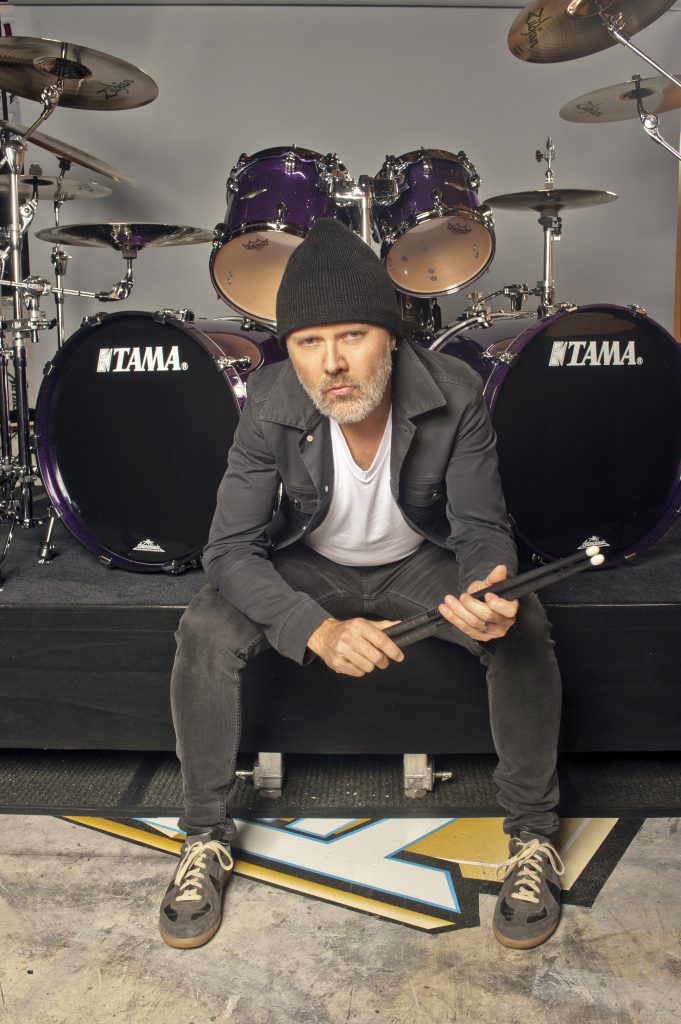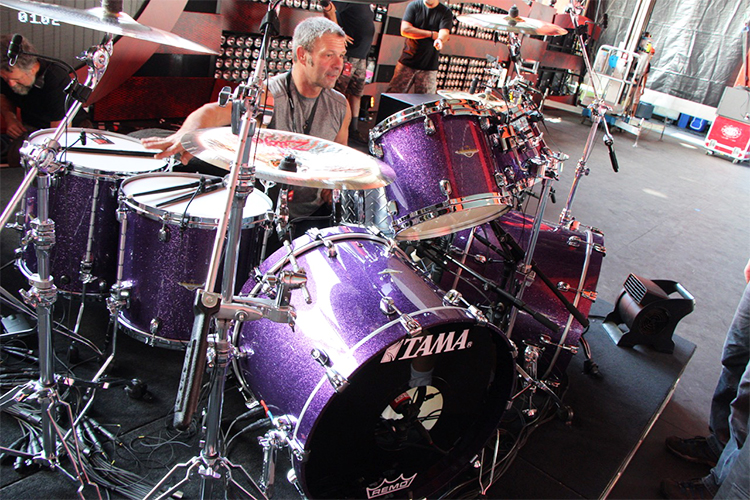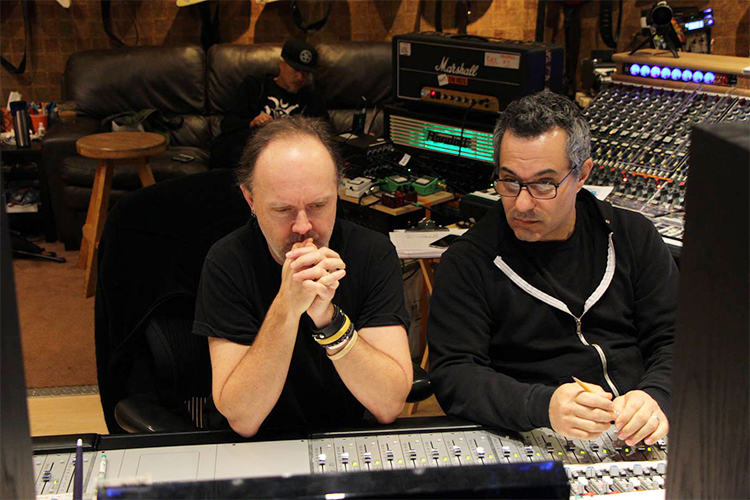From the February 2017 issue of DRUM! | By Jake Wood | Photo By Jeff Yeager
There’s a problem. “One of us didn’t quite make it here,” bellows James Hetfield to a percolating crowd of thousands. It’s 2004, and an hour after Metallica was scheduled to play the Download Festival in England, Hetfield emerges to inform the audience that Lars Ulrich cymbals wouldn’t be making the show. He was bedridden in a hospital in Germany with a health related “condition.” To date, this is the only Metallica show he’s ever missed in more than 35 years of playing with the band.
Thankfully, that episode is long past and he’s is back on his feet, which, from a literal standpoint is kind of a big deal. His feet are monumental. His feet, alone, have stamped out a legacy that inspired thousands of drummers. There are probably more people listening to his feet than there are people listening to the president’s mouth, and that’s not necessarily an exaggeration.
With over 37 million followers on Facebook alone, that’s roughly 12 percent of the 319 million people in the US (imagining that all their FB followers are domestic). That means one out of every ten Americans is a Metallica fan, which in turn means a new Metallica fan is born roughly every 2.5 minutes in the United States (assuming a US birth rate of one baby every 14 seconds).
That’s an entire army, a legion of metal heads. That’s power, and yet, when Drum got the chance to sit with Ulrich in the unassuming Metallica headquarters, he offered no hint of being the commander in chief of the world’s largest metal militia.
CLUB MET
In sunny Marin County, California, home of numerous stars, spandex-clad cyclists, and the butt of many Robin Williams’ racially charged jokes (the late comedian also lived in Marin), sits Metallica headquarters. It’s an unassuming warehouse nestled in an industrial block. Across the street, children are innocently at play during their school recess, perfectly unaware they’re neighbors of the beast.
Inside the HQ, expecting to find hot tubs, gilded bannisters, and butlers with etched pentagram monocles, it’s a shock to see a room gridded out with cubicles. No pet Komodo dragons, no gratuitous beds of cash — just a typical office setup. Turns out Metallica is way more than just a band; it’s a business, and the building is bustling with staffers running the fan club, website, social media, and the merch department.
Just behind cubicle city, however, is the gem we’ve all dreamed of seeing. The lair, the pit of despair, the place where black is the only color in the rainbow — yes, it’s the studio where Metallica wrote and recorded its latest release, Hardwired … To Self-Destruct.
As seen in many behind-the-scenes Youtube clips, the studio is enormous and packed with gear and metal memorabilia. With a high ceiling, guitar amps everywhere, the drummer’s latest kit, and a barrage of microphones, it’s like walking into the heavy metal version of Disneyland.
As with any business, there’s a buzz of production as many folks, including Ulrich’s drum tech, Jimmy Clark, and Metallica’s go-to engineer for the last decade, Greg Fidelman, float through the compound performing their various tasks. Among those worker bees is Ulrich, diligently maintaining the empire.
Today he’s wearing a standard issue black crew T-shirt with reading glasses hanging from the collar, denim jeans, some Stan Smiths (his wife thought he’d look cool in those), and the signature toothpick in his mouth that subconsciously broadcasts a mafia-esque undertone of: “You know, I hit things for a living.”
He’s just gotten out of an hour-and-a-half-long meeting with Snapchat and jumps right into this interview with warmth and earnestness. That said, it’s also lunchtime, and the man brings with him a plate of two sad-looking oat-bran pancakes. While it’s no kale salad, it’s still a somewhat healthy choice, and not a surprise after hearing about the changes the band has made in order to maintain a more healthful working environment.
 Infographic: JUAN CASTILLO
Infographic: JUAN CASTILLO
THE LONG GAME
They’re thinking big picture here, as Ulrich states: “We’ve kind of taken the reins a little bit and made some boundaries around our work ethics that prioritize keeping the band and the members as healthy as possible. It’s the best for the band in the long run, in terms of sustaining a kind of functioning collective that may have a chance of still being around another 15 or 20 or 25 years from now.” In addition to lunch options, the band has also taken a step back from the draining workloads and debilitating, yearlong tours that once fed the beast.
To clarify, though, they still work their asses off. Ulrich notes, “Since 2005, we’ve basically been going more or less full-on. A month off here, a couple months off here,” but nowadays it’s with a different approach. “Touring continuously is like having the band at ten. Making the records is having the band at ten. And then having off time is zero. Back in the day we’d go ten-zero-ten-zero-ten-zero. Now we’re constantly at seven. We’re always engaged, but not to the point of overkill. It’s this beast that doesn’t hibernate.”
Ulrich further examines the trends in the music industry, noting that 20 years ago, when “you made a record you didn’t do anything other than make that record. And when you went on tour, you toured, and that was it. Now it’s all interconnected, intertwined. It all overlaps.” So why all the changes? “We prioritize parenthood, we prioritize partnerships, we prioritize living somewhat domestic lives. I’ll stay away from using the word ‘normal.’”
Normalcy or no, grueling tour schedules have been known to cripple relationships, tear groups apart, and drive band members crazy. “We got into this thing about touring sporadically, and that was something we really liked because every time we left the house we knew we were coming back in two weeks. And that’s a different psychological undertaking.
And you can always see the end, rather than, ‘Now I’m leaving the house for a year and a half and I don’t even know what the hell is going to happen.’ We adopted that model for the Death Magnetic record, which was almost 200 shows around the world in two-week increments.” Ulrich is quick to add, however, that this touring practice isn’t the most economical, but that leads to a better experience for concertgoers.
“Ultimately, you’re going to have a better version of Metallica, because we’ll still keep wanting to do it. We understand it’s more expensive to tour the world in two-week increments, but we feel that it’s an investment in the health of the band and the sustainability.”
Within this newer workflow system, the band has plenty of downtime, and Ulrich uses this time to take a practical approach to his craft. “If we’re not playing, I try to get behind the kit a couple times a week just to sustain the callouses,” he says. And when they’re in heavy work mode, “We have a couple guys that basically work with us full time on working out, stretching, massaging, keeping the physical elements as relevant and as working as possible. When we go on the road we have a guy that makes us healthy meals.”
As for the partying that typically accompanies the touring lifestyle? “I still drink, but I don’t drink very often. Maybe twice a week. A couple glasses of wine, a couple glasses of champagne. But the days of waking up in gutters and all that kind of stuff doesn’t quite happen anymore, especially with being a parent.”

Photograph: PAUL HAGGARD
HARDWIRED
Although the band might be operating on a healthier, less intense workflow, they’re still cranking out plenty of material, including Hardwired, a two-disc album that took roughly three years to create. When asked if there was a concept or direction to the album, Ulrich says, “This time around we just basically showed up and started playing music. There weren’t any particular bigger-picture meetings.” Their last album, Death Magnetic, was a very different story. “There were a lot of talks, and a lot of meetings, and a lot of soul searching, and we hadn’t made a new record in a long time,” he says. “Rick Rubin came in to helm and Rick’s M.O. is: ‘Who are we; where are we going; where have we been; what do we want to do?’”
Many bands with extensive catalogs and widespread success are bound to the reputations of their previous releases, facing the pressures of having to follow the path of their back catalog, somehow top it, or risk alienating their audience by deviating from the music their fans have come to love. Such pressures can hinder creativity. And yet, Metallica is fueled by something more primal — the desire to create.
Ulrich notes that Hardwired was made using the same democratic, riff-building approach the band has always used. “Everyone has a riff, and then we sit and piece those together into songs, but nobody brings in finished songs. Everything in this band is very public, or ownerless.” There’s none of that ‘Here’s my song, here’s your song, and there’s this person’s song, and now the only way this is going to work is if we all have a song on the album.’”
This ownerless approach to songwriting is also somewhat ironic, considering that Metallica was the first band to sue the peer-to-peer file sharing company, Napster. Then again, that was 16 years ago, and both the band and the music industry have since gone through many changes regarding the concept of artistic ownership. Somewhat surprisingly, Metallica’s catalog is available on Spotify, the music streaming service that has had a far more severe impact on music sales than those wild-west days of Napster.
In terms of song creation, Ulrich stands out as the unofficial arranger of tunes, commonly taking the helm in many of the rehearsal videos they release. Instead of just working on his drum parts, he’s neck-deep in the fray, dissecting and assembling all aspects of a tune. “James [Hetfield] usually spits out more riffs than you’ll know what to do with, and I’m the one that sort of connects the dots. That’s kind of how it’s always worked since 1983.”
When it was time to track, they began the Hardwired sessions by recording bunches of three to four songs at a time, with Ulrich noting that “50 to 75 percent of the songs were recorded with a click,” mostly for the logistical purpose of keeping the parts consistent within the takes, in case they wanted to do any comping.
THE CLICK DRUM
Although it’s entirely subjective, Hardwired may present the best drum tones of any Metallica album to date, and that’s saying a lot, considering that 1988’s … And Justice For All’s utilization of the “click drum” forever changed the way drums are mixed on metal albums. According to Ulrich, those pivotal drum tones were essentially “happy accidents.”
“The rhythm guitars at that time took up the whole sonic spectrum, so you had to figure out a way to weave other stuff in,” he explains. “One place the rhythm guitar doesn’t live is in the 5k or 8k [range], or stuff that’s usually reserved for cymbals or the top [frequency] of the snare, but if we put that on the kick drum, then at least it’s audible.” And thus the “click drum” was born, a tone that many metal and punk drummers strive to emulate.
A new and improved Click Drum 2.0 cuts through the mix in Hardwired, as does a snare that sounds like it has been perfectly tailored with a compressor to make it pop, in an infectious combination of crack and resonance. In order to get such results, Ulrich surrounded himself with a team of experts, including drum tech Clark and audio engineer Fidelman.
While he admits to not being thoroughly versed in the technical side of recording, Ulrich still has opinions. “I obviously know what I like and what I don’t like, and Greg [Fidelman] and I talk about getting more size or more crack or more depth in the bass drum.” As far as crafting these particular tones, there wasn’t a single “Eureka!” moment, but instead a steady whetting of the sonic blade. “Greg has basically done every single thing we’ve done in the last ten years. So, he and I have homed in more and more over each project on exactly what it is that sounds good and what works with Metallica.”
THE HITS
A lot stands out on the new album: the overall energy, the presence of every instrument, the tightness of the band, the brutal execution of the parts, the relentless onslaught of Hetfield riffs, and the barrage of rapid-fire sixteenth-note double kick lines.
There are also some classic oddball timekeeping sections on the heavy enigma of “ManUnkind.” When asked about counting that groove, Ulrich happily passes the buck by proclaiming, “You’re asking the wrong person! I’m sure that in some Cherry Lane book soon you’ll be able to read what time signature it is. Don’t ask me because I just play it. I can’t analyze it and I don’t have enough schooling or knowledge to tell you.”
Another beefy track, “Am I Savage,” features a swinging guitar riff that insists drummers sit down and play along. It’s also the kind of riff that leaves plenty of room for overplaying, yet Ulrich sticks to a supportive role, rather than a fireworks show. “It was about trying to set up some grooves and some vibes, some creating of moods, rather than showcasing.
Second of all, on the last record, Rick was quite encouraging and pushing us. His favorite word was ‘ridiculous,’ and he’d sit there and say, ‘Make it more ridiculous. Make it more ridiculous.’” In a deadpan reply, Ulrich jokes, “Okay Rick, we’ll make it more ridiculous.” While there was clearly a “push to make that record crazier,” Hardwired was “the opposite, and was more about swing and about vibe.”
GROOVE THEORY
As his catalog proves, Ulrich is very much about groove and feel, getting most of his inspiration from some of the great groove drummers. Considering an alternate universe in some parallel dimension, he wonders, “What would happen if Phil Rudd played ‘Enter Sandman’? What would happen if Charlie Watts played ‘For Whom the Bell Tolls’?” Bedlam? Madness? Surely the metal militia would reject the foreign cells, yes?
And yet Ulrich further glorifies Rudd’s selling points. “His whole signature is basically that the kick drum is kind of on with the beat and the snare drum lags significantly behind, to give it that slight tension, that slight hesitation.
Most of the L.A. guys, they all play way too on the beat for my taste. Phil puts the snare drum sort of behind the click rather than on the click. That’s like my wet dream. That makes me salivate. That’s the greatest thing. Hearing Phil Rudd play behind James Hetfield – that’d be pretty cool.” Ulrich further amends his last remark with another deadpan zinger: “Maybe for 15 minutes or so. Don’t overstay your welcome.”
When Ulrich was laid out on that hospital bed in Germany some 12 years ago, Rudd was not on hand to fill in at the Download Festival in England. “All these awesome bands are there, everybody is super helpful. My drum roadie, Flemming [Larsen], played a few songs, and this guy played a couple songs and that guy played a couple songs.
” One of those guys was Joey Jordison, and he made a big splash subbing, but Ulrich was more concerned with someone else, a certain Dave Lombardo. “Do you want to try and lie in a hospital bed in Germany while Dave Lombardo is onstage in your shoes? That was not a lot of fun. And obviously, I say that with nothing but love and respect and appreciation, but it’s like, ‘F**k! Dave Lombardo is going to run away with the whole thing.’”
FOCUS
Remember those sad oat-bran pancakes Ulrich walked in with? Well, at the end of the interview they’re completely untouched. More than an hour went by and not a bite. He was too engrossed in the interview to eat, and now he has to leave to go pick up his kids from school. The man missed lunch for this, and it says a lot about his focus and his general work ethic towards furthering the Metallica machine.
The band is healthier, perhaps a little bit slower in the production realm, but the beast still has teeth. It has claws, and it most definitely has an appetite, just not for sad oat-bran pancakes.
For more on Lars Ulrich’s drumming on Hardwired … To Self-Destruct, see Andy Ziker’s Groove Analysis of the songs “Hardwired,” “Atlas, Rise,” “Now That We’re Dead,” and “Moth Into Flame.”

Photograph: JEFF YEAGER
Robert Trujillo: Who’s On Third Bass?
It’s true: Robert Trujillo is the “new guy” in Metallica. But since he’s held that distinction for 13 years, he’s nonetheless more qualified than anyone else to reflect on the dynamic that he and Lars Ulrich have developed.
“In this situation, the role of the bass player is to supply the overall foundation between Lars and James [Hetfield],” he explains. ”Lots of metal drummers rely a lot on the rhythm guitar, but James needs the support of the bass and the drummer as both our singer and our rhythm guitarist. I also think of myself as the heavy punching bag in this band, to keep the weight there, but to allow the riff to still speak and not clutter things up too much.”
Trujillo was already known around and beyond L.A. as a ferocious and technically adept bass player when he connected with Metallica. His history embraces both thrash metal monsters Suicidal Tendencies and the kind of post-fusion jazz epitomized by Jaco Pastorius, about whom he even produced a documentary film tribute, Jaco, released in 2014.
All of this gives the Venice, California-born virtuoso a perspective on his partnership with Ulrich that’s both deep and broad. “From when I joined the band, Lars has just grown better,” he says. “The pocket has come a long way. That’s why I feel that his ability to groove has blossomed even more on the new album. We’re growing as a rhythm section. That’s a beautiful thing because I feel that the whole band, as a unit, is still challenging itself.
“Lars likes to play,” Trujillo adds. “By that I mean that he likes the drums to have a voice. It reminds me of the way Jaco played: They both have a melodic quality that fits in really well with anybody they work with. There’s a lot of personality in Lars’ drumming. That’s what makes it unique.”
Clearly Trujillo admires Ulrich’s playing, to the extent that he can bristle at those he perceives as less appreciative. “I’ve played with the best drummers in rock, ranging from Josh Freese to Brooks Wackerman to even Dave Lombardo. And these guys respect Lars. They know he has a unique style of playing and production. Some drummers who don’t have the kind of success Lars has had are quick to pass judgment. I don’t know if it’s jealousy or whatever. But the really great drummers have mad respect for him.”
— Bob Doerschuk

Jimmy Clark’s Dream Gig
Two years ago, after a long run as head carpenter on country superstar Kenny Chesney’s tour, Jimmy Clark found himself back home in Nashville with a bunch of empty dates on his calendar. So, he called his friend Tony DiCioccio at Q-Prime Management who said, more or less, “Have I got a gig for you!”
Shortly after that, Clark was on the road with Metallica, as a carpenter/rigger, working in what he remembers as “all the cesspools in Europe. Then one day, when I didn’t have much to do, I introduced myself to Flemming [Larsen], who had been Lars’ drum tech through the duration of his career. He was cleaning cymbals, and I said, ‘Hey, Flemming. Can I help you out?’ He said, ‘Sure, man, if you want to.’ He gives me the 18″ crash, some polish and some rags, and sends me on my way.”
Clark smiles. “Now, as Lars will tell you, I’m the cymbal polish connoisseur. I won’t play my kit if they’re not clean; it’s a pet peeve I have. So, I bring the crash back to Flemming in 15 minutes and he loses his mind – not in a good way. He goes, ‘Oh, no! That’s too good! I’ll never get the rest of them to look like that!’”
Being no dummy, Clark replied, “Hey, I’ll do ’em all. I’d be happy to.”
The Metallica trek ended shortly after that and Clark went back to Chesney. But Ulrich had taken note of that new gleam in his cymbals, so when Larsen decided to take time off in 2015, DiCioccio called with an offer that Clark couldn’t refuse.
Now onboard as the band’s official drum tech, Clark has made only minimal changes to Larsen’s approach, always with Ulrich’s knowledge and approval. “I locked all the legs of his drums down on the riser with conduit anchors so nothing ever moves,” he points out. “And I tuned his toms up maybe half a step to cut through a little better,” he notes. “‘Big Mick’ [Hughes], our front-of-house engineer, likes it better. So now when Lars goes through all his toms, you can hear them as opposed to just seeing him play them.”
A lifelong Metallica fan, Clark still occasionally has trouble believing that he’s working with one of his great influences. “I’ve already told him, ‘I’m here until you retire,’” he says. “That’s my plan: I’ll retire with him.”
—Bob Doerschuk

Greg Fidelman: Building A Plywood Palace
Making an album for a band like Metallica is daunting enough, but chief engineer Greg Fidelman faced a dicey problem before even a note of Hardwired had been tracked. He was tasked with recording Lars Ulrich’s kit in Metallica’s warehouse, which isn’t the most flattering space for drum tones.
“A big room doesn’t equal a good big sound,” says Fidelman, who has engineered and mixed Metallica’s releases for the past nine years. But when the band chose the warehouse — because they wanted a more “lively” and “ambient” sound than the last album, Death Magnetic — Fidelman strapped on his tool belt.
He experimented with various types of plywood positioned in various ways around the drums, and settled on traditional plywood on the walls and a more reflective wood on the floors. Though the timber testing took an entire week, it dramatically changed the sound of the overheads, as well as room mikes placed 12 feet above the kit.
For that killer snare tone, Fidelman used three close-mikes on top: an SM57 and Neumann KM84 taped together, and a Neumann KM86. “The majority of that snare sound is probably 70 percent those close-mikes, and the other 30 percent is the combination of those overheads and what’s in the room.” He also set up a side-chained gate on the room mikes that would open up a tiny bit for each snare hit, adding more ambience to every crack.
Fidelman was very involved with the snare choices, and after auditioning some 15 snares, they settled on Ulrich’s signature steel plate snare by Tama. The drummer’s heavy hitting caused the snare to go out of tune after almost every take, so they had an array of some four or five snares of the same model in rotation. All were tuned identically, so they could be swapped out after every take, no listener being the wiser and all the while keeping the creative momentum in the studio at full tilt.
—Jake Wood
